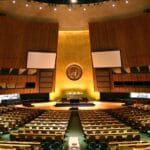The shared sins of Soviet and U.S. nuclear testing
By Hugh Gusterson | September 29, 2009
Gerald Sperling’s new film, Silent Bombs: All for the Motherland, recounts the effects of decades of nuclear testing on Kazakh villagers near the Soviet nuclear test site at Semipalatinsk. The film is at once very particular to Kazakhstan, the exotic ambience of which is evoked with a sad lyricism, and, in a disturbing way, generic to the nuclear age. It evokes something that is simultaneously strange and familiar.
The Soviets tested around 500 nuclear weapons in northeastern Kazakhstan between 1949 and 1989. Until 1963 the tests were all aboveground. Some of these tests left behind massive craters that have become atomic lakes. Even when testing moved underground, tests often vented, according to the filmmakers.
One might hope that a democratic superpower and a totalitarian superpower testing nuclear weapons would behave differently. However, the convergences between the Soviet and U.S. malignant abuse of indigenous peoples on whose land they tested these weapons–their callous abuse of the weak and indifference to the dignity of a preindustrial way of life–are too striking to ignore.”
These nuclear tests cut a swathe of human destruction. According to one doctor interviewed by Sperling, the cancer rate nearest to the test site’s center is twice that of Hiroshima survivors. Birth defects, formerly rare, are now common, and some families saw as many as one-third of their children die. Today, nuclear testing may be over, but the water and the local livestock are still contaminated. In effect, the Soviets waged a kind of slow-motion nuclear warfare on some of their own people. Needless to say, they have refused to pay any compensation. Moscow, in the words of the film’s narrator, blames the poor health of the villagers on “anything but exposure to nuclear contamination. It was the fault of poor diet, inadequate sanitation, a harsh climate, and the faulty genes of the Kazakh people from time immemorial.”
The Canadian team behind this film evokes the era of nuclear testing, and the legacy it left behind, through a mixture of Soviet archival footage, subtitled interviews with contemporary doctors and villagers, and moody shots of Kazakh village life set to spare indigenous music. The archival footage includes the usual pornographic money shots of mushroom clouds that have become such a cliché in this genre of documentary filmmaking, but also interviews with Yuli Khariton, the Soviet Union’s J. Robert Oppenheimer, Andrei Sakharov, the Soviet hydrogen bomb designer turned environmentalist and dissident, and the Kazakh poet Olzhas Suleimenov. It was Suleimenov who, scheduled to read his poetry on television in 1989, threw away his script and, at considerable danger to himself, appealed to the Kazakh people to attend an emergency meeting about the environmental emergency the Soviet test site had created. The archival footage of this meeting and subsequent protests, little known in the West, is fascinating and powerful. Suleimenov is a courageous and intense man about whom we need to know more.
But the center of gravity of the film is occupied by the tragic figures of the Kazakh villagers themselves and the medical professionals who must help pick up the pieces of their lives. The filmmakers lived with the villagers for weeks, sometimes without heat or running water, earning the trust of their subjects much like anthropologists. They are rewarded with candid scenes of daily village life and footage in which Kazakhs, sometimes against the colorful backdrop of their magnificent textiles, speak to the camera with an enigmatic stoicism. One woman quietly recounts seeing a nuclear test that blinded her. Another sits patiently next to her mentally handicapped adult son as she is interviewed. Some of the footage, especially the two-year-old child born without a brain, is hard to look at.
While Moscow may have no interest in providing medical or financial assistance to the Kazakh villagers today, it very much wanted to study them when the testing took place. “Tests were conducted on us as if we were laboratory rabbits,” recounts one woman. Former Soviet medical researchers admit that they were threatened with prison if they spoke about the medical syndromes they were documenting. When one protested about the human cost of nuclear testing, he was told, “You can’t chop wood without wood chips flying off.”
What struck me when I was watching Silent Bombs was the familiarity of the story. While the scenes of Kazakh villagers and the wide shots of the Kazakh landscape will seem exotic to an American audience, the images of houses being blasted apart and trees bending almost to the ground during nuclear tests could have come from the Nevada Test Site. The cold denials of responsibility may be spoken in Russian, but the underlying language of bureaucratic stonewalling and indifference will be familiar to U.S. atomic veterans who struggled for decades to be compensated for the ills inflicted on them by their own government in the name of national security. Meanwhile, for anyone who has seen Dennis O’Rourke’s fine documentary, Half-Life, about the effects of U.S. nuclear testing on the indigenous Marshall Islanders, Silent Bombs will be déjà vu all over again. Similarly, the Marshall Islanders had the misfortune to find that their simple, isolated existence made their home an ideal place for nuclear testing. In turn, they too have suffered an epidemic of cancers, birth defects, and miscarriages with which they are still grappling in the absence of significant financial assistance from the superpower responsible for their suffering. (See my October 2007 column, “The Effect of U.S. Nuclear Testing on the Marshallese.”) And they also became human guinea pigs for military doctors seeking to understand the health effects of radiation.
This might be the most depressing conclusion to be drawn from Silent Bombs. One might hope that a democratic superpower and a totalitarian superpower testing nuclear weapons would behave differently. However, the convergences between the Soviet and U.S. malignant abuse of indigenous peoples on whose land they tested these weapons–their callous abuse of the weak and indifference to the dignity of a preindustrial way of life–are too striking to ignore. Robert Jay Lifton has argued in a series of books that “nuclearism” is a social formation with its own logic that transcends the differences between capitalism and communism, democracy and totalitarianism. In Silent Bombs, we see the particularity of Kazakh suffering, but also the generic behavior of the nuclear state during the Cold War.
Together, we make the world safer.
The Bulletin elevates expert voices above the noise. But as an independent nonprofit organization, our operations depend on the support of readers like you. Help us continue to deliver quality journalism that holds leaders accountable. Your support of our work at any level is important. In return, we promise our coverage will be understandable, influential, vigilant, solution-oriented, and fair-minded. Together we can make a difference.
Topics: Columnists, Nuclear Weapons















